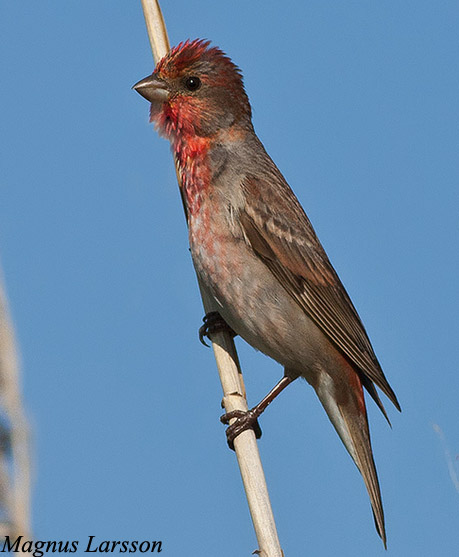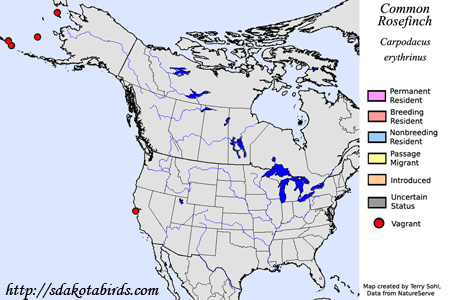| Length: 5.75 inches | Wingspan: 9 inches | Seasonality: Non-resident in South Dakota |
| ID Keys: Male with rosy head, breast, and rump, light belly, strong bill | ||
 The
Common Rosefinch is found throughout much of Europe and Asia, where they
have been expanding in range in recent decades. They are vagrants in North
America, having been found in Alaska on several occasions.
The
Common Rosefinch is found throughout much of Europe and Asia, where they
have been expanding in range in recent decades. They are vagrants in North
America, having been found in Alaska on several occasions.
Habitat: Found in shrubby areas during the breeding season, including brushy fields, forest edges, forest clearings, and fence rows. Found in similar habitat in migration in winter, but also found in suburban and agricultural areas.
Diet: Feeds heavily on seeds in all season, but supplements with insects during the summer breeding season. Also feeds fledglings insects. Fresh buds, nectar, and small fruits are also consumed.
Behavior: Forages on the ground or low in vegetation.
Nesting: The nest of a Common Rosefinch is a cup built of grasses and weed stems, lined with finer grasses, roots, and hair. It is placed low in a bush or small tree, usually within 4 feet of the ground. The female lays between 3 and 6 eggs, and she alone incubates them. Once the eggs hatch, both parents help to raise the young.
Song: Slow, flute-like song with emphasis placed on alternative syllables.
Migration: Migratory, with breeding populations stretching from northern Europe through Asia, to eastern Russia. In winter, found in Iran, China, India, and locally elsewhere in southeastern Asia.
Feeders: Will come to feeders for a variety of commonly offered items, including millet and other offered seeds, peanuts, suet, and fruit.
Interactive eBird map: Click here to access an interactive eBird map of Common Rosefinch sightings
Similar Species: When found in North America, most likely to be confused with House Finch, Purple Finch, or Cassin's Finch.
Conservation Status: Populations are seemingly in decline, but they are still numerous and are found across a very wide geographic area. The IUCN lists the Common Rosefinch as a species of "Least Concern".
Further Information: 1) Whatbird - Common Rosefinch
2) BirdLife International - Common Rosefinch
3) Royal Society for the Protection of Birds - Common Rosefinch
Photo Information: Photo by Magnus Larsson - Licensed under Creative Commons Attribution NonCommercial NoDerivs 2.0 Generic License.
| Click below for a higher-resolution map |
 |
| South Dakota Status: Non-resident in South Dakota |
Additional Common Rosefinch Photos (coming soon!!)
